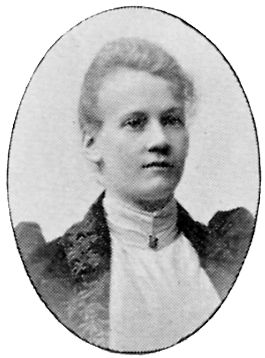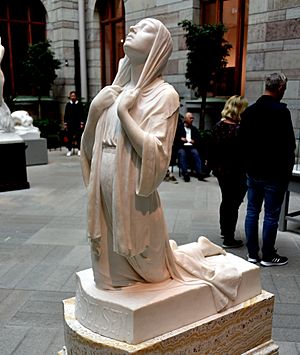Sigrid Blomberg facts for kids
Sigrid Blomberg (1863–1941) was a talented Swedish artist who created sculptures. She was especially known for her religious artworks. One of her most famous pieces is Bebådelsen (The Annunciation), a beautiful marble statue made in 1900. It shows the Virgin Mary praying on her knees. This sculpture was very important because it was the first artwork by a woman that the Swedish National Museum ever bought. Later in 1912, after making a wooden sculpture called Madonna del Fuoco, Sigrid had to stop sculpting because her eyesight got very bad. After that, she worked as a bookbinder, which means she made and repaired books.
Early Life and Education
Sigrid Blomberg was born on October 17, 1863, in a place called Fliseryd in Småland, Sweden. Her father, Johan Alfred Blomberg, was a farmer, and her mother was Charlotta Eleonora Lundqvist. Sigrid grew up on her family's farm with her five brothers and sisters. She went to a girls' school in Kalmar.
Sigrid first wanted to be a carpenter, so she went to the Technical School in Stockholm in 1888. But there, she discovered how much she loved working with clay and decided to become a sculptor instead! From 1889 to 1898, she studied at the Royal Swedish Academy of Art. She also took a special course in etching, which is a type of printmaking. During her studies, she spent three years in Germany, mostly in Dresden, learning even more about art. In 1894, she won a special medal from the Academy for her sculpture called Ormtjuserskan (Snake Charmer). This artwork was later bought by Västerås Castle.
Famous Artworks and Recognition
Starting in 1896, Sigrid received many scholarships. These awards helped her continue her art studies. In her last year at the Academy, she won the Royal Medal for her small statues of Kristus (Christ) and Maria (Mary). These were part of a group of five figures she made for Oskarshamn Church, which were finished in 1899.
In 1898, Sigrid made a plaster model for her most famous sculpture, Bebådelsen (The Annunciation). This model was first shown at the Academy. The final version, made from marble, was created in Italy under Sigrid's careful watch. The National Museum bought it in 1900. People who visited the museum really loved the statue of the Virgin Mary kneeling in prayer. It became so popular that smaller versions were made from terracotta and sold to many homes in Sweden.
Later Career and Life
In 1900, Sigrid joined a women's group called Nya Idun. There, she met Sigrid Leijonhufvud, and they lived together. Because Sigrid Blomberg received many requests to create religious artworks, she was able to have her own art studio in Italy from 1900 to 1912. She made monuments for graves at the Östra Cemetery in Gothenburg and a special stone coffin, called a sarcophagus, for the monument of a writer named Viktor Rydberg.
In 1912, Sigrid created her last sculpture, a wooden piece called Madonna del Fuoco (Madonna of the Fire). She was inspired to make it by looking at the flames in her fireplace. After this, her eyesight became too poor for sculpting. So, she started a new career as a bookbinder, earning her living by making and repairing books.
Sigrid Blomberg passed away in Karlstad, Sweden, on January 28, 1941.



